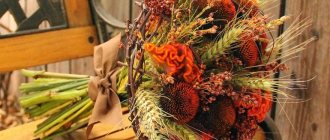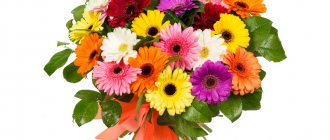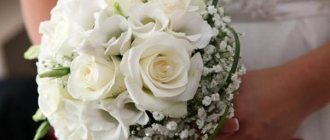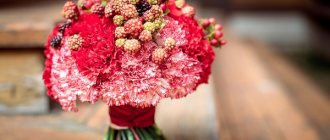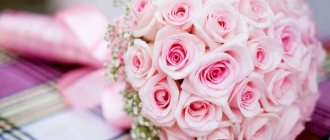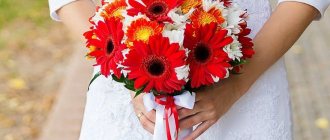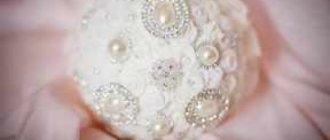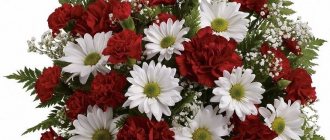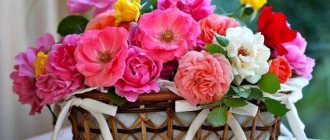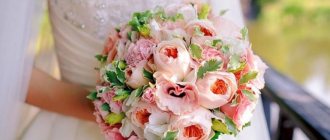Flowers at a wedding are considered a necessary addition to the overall atmosphere of the celebration. Roses are considered to be the traditional inflorescences of love. But who said that wedding celebrations should be decorated with the same type of plants? For example, the bride's bouquet, as one of the main attributes of the holiday, can be diluted with other flower arrangements. Bouquets of chrysanthemums in combination with roses, as well as mono-variants of these plants, look great at a celebration.
Bridal bouquet of chrysanthemums and roses
Symbolism
The fluffy, graceful flower came to us from the east , from China and Japan, where it symbolizes the sun, imperial power, fortitude and nobility. Interesting! Initially, the flowers were exclusively yellow in color, and therefore they were called golden.
It was believed that if the bride herself made a bouquet of these sunny buds, then her marriage would be blessed in heaven. Modern floristry interprets the meaning of chrysanthemums as resistance to any challenge, loyalty to each other and the spiritual strength of newlyweds.
Advantages
The advantages of chrysanthemums include:
- hardiness , these flowers will withstand both frost and scorching sun, and therefore they are used at weddings all year round;
- a huge palette of shades and varieties , allowing you to choose something to suit every bride’s taste;
- good compatibility with other plants : chrysanthemums are absolutely not jealous;
- long life : for another two weeks after the celebration, the inflorescences will continue to delight you with their fresh appearance and enchanting aroma;
- universal appearance , suitable for any look: from classic to stylized;
- availability throughout the year;
- budget.
Varieties
There are 140 species of chrysanthemums in the world, but only about half are used in floristry. But even this quantity is enough to create an exclusive wedding bouquet that can please even the most demanding girl.
According to your taste and imagination, chrysanthemums are:
- large-headed (wide open basket with long, needle-like petals)
- bush (medium or small flowers united into one branch)
- spherical
- anemone-shaped
- pompons
- semi-double
- terry
The last 5 types of flower are all artificially created and grown.
Bouquet with chrysanthemums and roses
Chrysanthemum breeders have not deprived the chrysanthemum of a variety of shades. This flower can be of absolutely any color: red, purple, lilac, yellow, orange, white, blue, variegated and even green! Such a riot of colors allows you to enjoy extravagant, catchy or romantically delicate bouquets - whatever you want, the chrysanthemum can embody in itself.
What kind of brides is it suitable for?
Chrysanthemums are universal, so they are suitable for both a very young, anxious girl and a chic older woman. A variety of shades and shapes will help you create a magical accessory for any wedding theme and overall wedding look:
- Gentle, dreamy natures will like pastel and light shades;
- Bright optimists will like compositions of orange or red inflorescences;
- Creative young ladies will appreciate the cool spectrum of colors - blue, blue, violet tones.
Due to their hardiness, chrysanthemums are the best option for brides who want to make their own wedding bouquet - the buds will withstand any experimentation. Also, flowers look great at any time of the year. In winter, they are not afraid of frost and contrast effectively with the snow-white snow. Pastel shades are chosen for spring, bright and rich – for celebrations in the hot summer, warm – for golden autumn.
Color spectrum
The most suitable colors for autumn:
- orange;
- burgundy;
- fiery red;
- yellow;
- gold;
- chocolate;
- silver;
- mustard;
- brown;
- dark green;
- terracotta;
- redheads;
- sand;
- eggplant;
- brick;
- purple.
Below we look at the most popular combinations for this time of year.
Red-green
The most classic of all the bouquets we presented. Any red buds - asters, roses, anemones - are usually taken as a basis.
Green notes are added with the help of hydrangeas, dahlias, chrysanthemums, as well as various herbaceous plants - this can be amaranth, molucella, eucalyptus.
Volumetric, disheveled compositions in this color look gorgeous.
Beige-burgundy-chocolate
This option looks noble, calm, but at the same time quite bright and fashionable in the hands of the bride. A beige shade can be achieved with roses, callas and orchids.
Burgundy is introduced with the help of chrysanthemums, zinnias, dahlias, ranunculus, and amaranth branches. And in conclusion, we complement all this beauty with chocolate cosmos and cotinus leaves.
Red-yellow-orange
Another common fall palette. For red, let's take, for example, gerbera, zinnia, marigolds, hydrangea, amaryllis. For yellow, add sunflowers or orchids. And roses and chrysanthemums will be responsible for the orange in our bouquet.
It is also appropriate to add some herbaceous plants; crocosmia, ornithogalum, celosia, salidalgo, which come in the shades in question, are suitable.
Large beautiful maple leaves can also add yellow colors to the bride’s accessory.
Purple
Such tones look truly magical, enchanting and bewitching. They are represented by callas and orchids, which are available all year round, and from the seasonal ones you can take ranunculus or dahlias.
To prevent the bouquet from looking gloomy, it is necessary to add light colors; roses, allium, lisianthus, and hydrangea will help us with this.
For volume, feel free to add mackerel, as well as other leaves and herbs.
But of course, which color to choose will depend, first of all, on the overall design of the celebration and on the desires of the young people.
It turns out to be very harmonious to combine pastel colors with bright elements: beads, ribbons, etc.
Palette of shades and their meaning
If earlier chrysanthemums were presented only in the yellow version, then modern floristry has developed a variety of varieties to suit every taste. Each shade complements the overall interpretation of the overall meaning of the bouquet:
- White chrysanthemums traditionally mean purity and innocence, the beginning of a new family life for the bride;
- Red flowers symbolize strong passion, attraction to each other through time and space;
- Yellow petals are closest to the traditional ancient interpretation - well-being in every sense: from divine blessing to financial independence;
- The blue color speaks of lightness, happiness, and an optimistic view of the future;
- Pink symbolizes tenderness, romantic love, caring for each other;
- Purple or lilac flowers emphasize the bride's originality and creativity.
Language of color
Why use words when you can express your feelings and emotions with a bouquet? And the form here plays far from the main role. It's all about the combination of colors - they serve as an indicator of mood and set the tone for the entire holiday. The predominance of any shades in the composition may mean the following:
- Pink - tenderness and romance;
- Blue/blue - fun, joy, optimism;
- White - innocence, fragility, sincerity;
- Red - passion, energy, expression;
- Yellow - trust, calm, warmth;
- Lilac - rebellion, character, charisma.
If the wedding theme requires the use of a specific color, but it is not currently on sale, then chrysanthemums can be painted with a special paint. But in this case, you need to remember that they won’t last long after the “execution.”
It is also worth considering the bride’s color type. For example, bouquets made of flowers in pastel shades: pastel pink, cream, peach are suitable for blondes. Brunettes will look bright and contrasting against the background of compositions of red, lilac, and orange flowers. And red-haired girls look great in the company of yellow and green chrysanthemums.
Wedding composition ideas
Chrysanthemums are divided into two large groups of varieties - bush and single-headed.
The first are branches with several miniature inflorescences. They look more natural, cute, and are perfect for compositions for a rustic or Provençal celebration.
The second are larger single buds on a strong long stem. They can be assembled into a round, cascading, or elongated shape.
The petals of both varieties can be double, smooth, curled or long.
Any variety looks great in a mono-bouquet, but if desired, the flower can easily be combined with any plants : from royal roses, orchids or lilies to more democratic ones - eustoma, peonies, alstroemeria, tulips, hydrangea.
Idea! Bacardi bush chrysanthemums look interesting - they look like a large rounded daisy, and therefore go perfectly with gerberas or wildflowers.
If you want to create a truly unusual composition, then feel free to combine succulents, pine branches, and dried flowers with chrysanthemums.
Bush varieties
Varieties with several inflorescences look very feminine, gentle and natural. Making a solo composition out of them is an excellent choice for both a variety of natural or vintage weddings, and for a completely classic celebration.
It is permissible to use several types of plants, different shades or shapes. This will add texture and bright colors to the bouquet, and will also allow you to play with interpretations and associations.
Try not to take more than three pure colors at a time, and green also counts. It is permissible to add more shades, but in any case, remember about moderation, because the bouquet should only emphasize the beauty of the bride, and not draw all the attention to itself.
An equally charming option is possible when using one color. White, cream, pink spray chrysanthemums will create a romantic and reverent image.
They don't need a lot of decoration. It is enough just to intercept the stems with a satin ribbon, lace, or a string of beads. A blue, blue, purple bouquet will perfectly highlight a snow-white dress and become a bright and sophisticated accent. A completely green composition is suitable for an eco-style wedding. In this case, you can use ordinary gray or brown twine as decoration - you will get a fresh and unusual picture.
If you want to add something else to the airy fluffy petals, then spray chrysanthemums look interesting with peonies, gypsophila, and hydrangea. A more sophisticated combination can be achieved by combining fluffy inflorescences with roses : small, large or vintage David Austin varieties.
Small flowers
Small inflorescences of chrysanthemums wonderfully fit into a round, spherical or hemispherical composition , creating a truly solid, delicate and airy accessory.
Idea! Very interesting are chrysanthemums that combine several shades, with a yellow core or with a border. They add texture and necessary accents to the bouquet.
For an unusual composition, you can choose the shape of a pomander - a sphere without a leg, attached to a satin ribbon. The accessory can be worn on your hand, which is quite convenient if you plan to move a lot, but do not want to leave the bouquet in the vase.
Compositions made from both white and colored chrysanthemums look funny. If you choose the most saturated or dark color - burgundy, scarlet, purple, then we recommend using the same shade in any other detail of the image - lipstick, hairpin, shoes. This will allow you to create a single harmonious composition.
Roses
The Queen of Flowers looks great framed by delicate chrysanthemums. It is better to use large rose buds as the main accent of the composition, and dilute bush roses with chrysanthemums in equal proportions.
Neat, elegant petals of larger pink buds will add aristocracy to the overall picture , regardless of whether the bouquet is monochrome or multi-colored.
A contrasting combination of scarlet or blue with white will suit bright, emotional girls who are not afraid to show feelings. Completely pink compositions look beautiful with pearl decor, and you can glue them directly onto flowers. An absolutely green or blue bouquet will appeal to extraordinary, creative people.
Roses are not very fond of their neighbors in a vase, poisoning them with toxic substances. Therefore, if you want the bouquet to please you longer, separate the flowers and place them in different containers after the wedding.
Eustoma
Eustoma is similar to a rose, but has a more democratic character and tenderness of form. A huge palette of shades allows you to select exquisite combinations - for example, from plants with the same gradient color.
Important! Eustoma, like chrysanthemum, is a hardy plant, so such a bouquet will definitely withstand even the longest wedding day.
Completely white bouquets interspersed with yellow or green hearts look no less chic. If you choose large, single-headed chrysanthemums, the bouquet will be more uniform and harmonious , but if you choose small, bush chrysanthemums, then it is better to place them along the edges, giving the leading role to the captivating petals of the eustoma.
Typically, delicate shades of pink or cream with a contrasting combination of yellow, red, blue or green chrysanthemums are used for weddings, but the opposite is also acceptable. Flaming scarlet or deep blue eustoma on the airy petals of white chrysanthemums is no less a stunning sight.
Roses and alstroemeria
Similar to small lilies, alstroemerias come in a wide variety of colors. Often their color combines several shades due to spots, stripes, and edging of the petals. The trio of these exotic plants with elegant roses and delicate chrysanthemums creates truly magical pictures.
It is very important not to overdo it with the number of shades, otherwise the bouquet will turn out too chaotic. A good idea is a cascade form with an abundance of greenery and small islands of buds of different types, but of the same shade. Very miniature bouquets with literally one large rose and a frame of several chrysanthemums and alstroemerias also look great.
Be sure to take into account the theme of the wedding, as some chic options look organic only if properly framed. First of all, these are rich dark tones of crimson, violet, and red. For a classic wedding, it is better to stick to pastel, powdery tones of white and pink.
Gerberas
Optimistic round gerberas symbolize joy, openness and at the same time emphasize the modesty of the bride. In a duet with chrysanthemums, these playful flowers are ready to act as both a bright accent and an equal participant, depending on the chosen color scheme and varieties.
A mono-bouquet in which gerberas and chrysanthemums differ from each other by a tone or two looks interesting. Such ensembles are made in both delicate and bright colors.
In the case of a completely white composition, we strongly recommend adding at least a little greenery so that the accessory has borders. This way it won’t blend in with the bride’s dress.
Since both plants are distinguished by strong, long stems, a bouquet of any shape is possible - round, cascading, scepter. The endurance of the petals will make the composition quite viable in specific forms - a fan or a pomander.
Carnations
Carnations are not the most frequent guest in wedding bouquets, but such neglect is completely undeserved, because the flower is distinguished by both its cute appearance and excellent resistance to cold, heat and drought. That is why a duet of carnations and chrysanthemums will be a real salvation for a winter or autumn wedding.
Advice! Cloves have a spicy and quite strong aroma, so if you don’t want it to overpower the smell of chrysanthemums, then choose white and pastel flowers. They smell weaker.
There is also the opportunity to show imagination in choosing a color palette. Carnations come in two colors, striped, and with a border. An interesting idea is to select a second flower to match the color of the neighbor’s stripes or core. The stem of the bouquet should be decorated with ribbons of both colors. Carnations also do well in pomander.
Bouquet of chrysanthemums with asters and dahlias
If the wedding is planned in the fall, then asters and dahlias will be an excellent addition to chrysanthemums. The former personify tenderness, loyalty and kindness, while the latter bring happiness and grace to the family. These flowers are also not prone to excessive aroma, which is especially important for allergy sufferers. In addition, the variety of color palettes is impressive, from which you can create real autumn masterpieces.
As additional “chips” it is good to use rose hips, bunches of rowan berries, cones and even yellowed leaves. The result is not only bouquets that are original in appearance, but also affordable.
Of course, the ideal option would be to use the services of a professional florist, but if you wish, you can make a wedding bouquet with your own hands. Moreover, the Internet is replete with many photos that can become a starting point for your own creativity.
How to keep it fresh?
Chrysanthemums are resistant to negative external influences , but any flowers are delicate creatures and love to be cared for. To ensure that your bouquet pleases you for as long as possible, we recommend using a few simple rules:
- Before putting chrysanthemums in water, be sure to treat the stems . Trim the bottom edge at an angle with a sharp knife or pruning shears, but never with scissors. You need to remove about 3 cm;
- All leaves that are below the water level must be removed , otherwise they will begin to rot;
- To create a bouquet, use already opened inflorescences , rather than buds, which dry out and wither faster;
- Do not place the vase in direct sunlight or drafts;
- Remove wilted plants in a timely manner , otherwise they will begin to poison their healthy counterparts;
- If the bouquet nevertheless begins to fade quickly, do not despair, because chrysanthemums can be revived . To do this, alternately place the flowers in hot and cold water for several minutes, then cut off another 5 cm of stems and place in a vase with water at room temperature;
- Another way is to feed cut flowers , which should be poured directly into a container of water. This could be a specialized mixture, regular sugar, or an aspirin tablet.
Bouquet of white chrysanthemums and red gerberas
First, you need to choose a combination of colors based on the style of the bride’s dress and the overall style of the celebration. The source material must be carefully inspected for visual defects, freshness, flower quality, and so on.
- Remove the lower leaves, leaving only the top greens and flowers.
- Place the prepared flowers on the table and bring the length of the stems to a single “denominator”.
- Decide on additional decorative elements for the bouquet. These can be fern leaves, asparagus, gypsophila, as well as various ribbons, figurines and other items for decoration.
- Flowers are collected in a bouquet. Gerberas are placed in a circle between chrysanthemums, slightly higher than the main level of the composition.
- Greenery and other decor are added.
- At the bottom, the flowers are tied with a cord and wrapped in tulle, moiré or satin ribbons.
Photo
A wedding bouquet of chrysanthemums is suitable for gentle, romantic natures; this accessory will make the newlywed’s image touching and sweet. Several options for compositions using this plant are in the photo:
Bouquet of blue chrysanthemums
Wedding bouquets made from contrasting flowers look interesting. For example, you can combine blue chrysanthemums with white roses or daisies. The composition is both gentle and eye-catching. As a rule, there are no difficulties in making such bouquets. The emphasis is on visual perception, and not on the use of rare varieties of flowers or greenery.
- Prepare starting materials. Clear the stems of leaves and thorns at the bottom, trim the ends lengthwise.
- Assemble a bouquet, placing roses in the center of the composition, and chrysanthemums and daisies in a circle. Add fern or asparagus leaves to the edges.
- Tie the lower stems with ribbon, tying them into a beautiful bow.
Important: in order to avoid mistakes in the process of creating a bouquet, you can watch relevant videos with master classes on the Internet.
